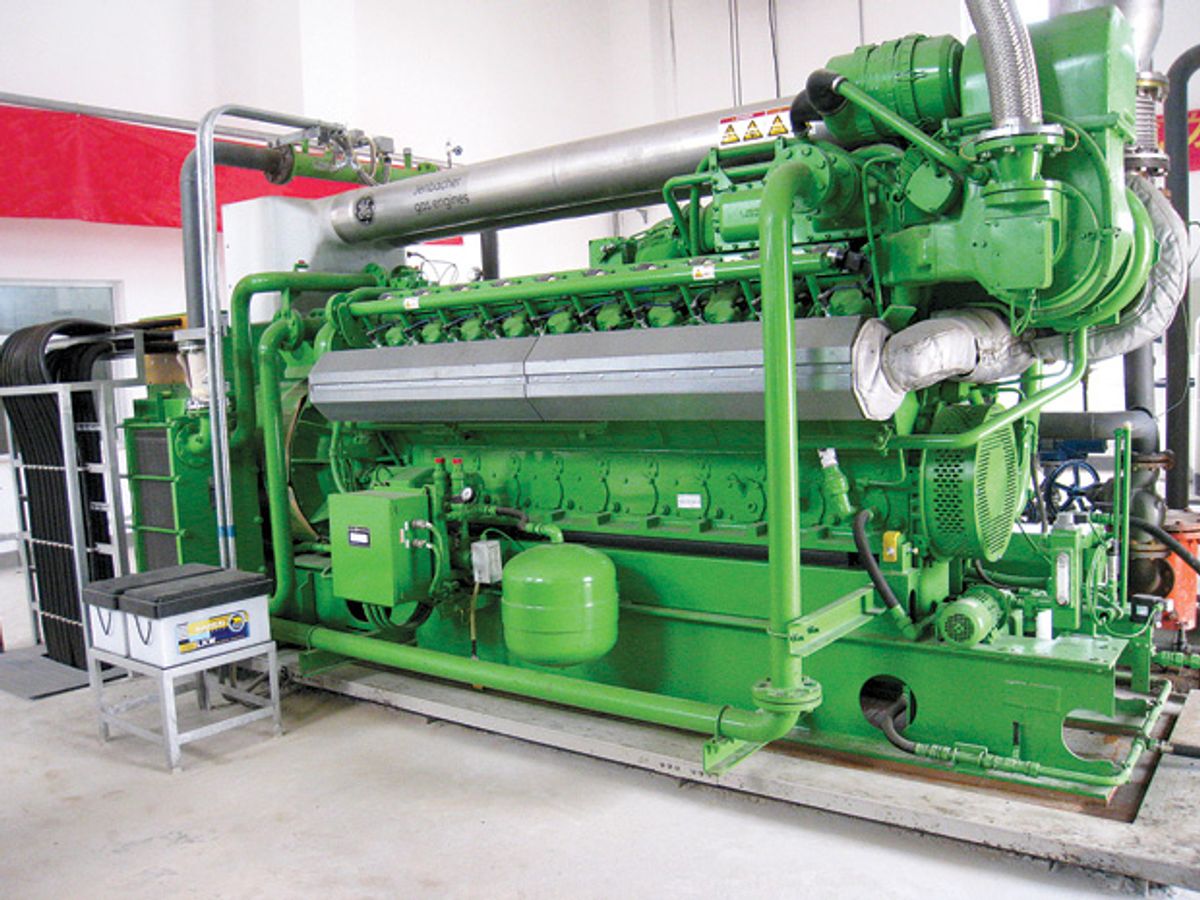Rooftop solar has long been the poster child of distributed energy, but experts say the boom in the natural gas supply and memories of large-scale outages are also playing a big role in moving electricity generation out of the hands of big utilities.
Different gas-fueled technologies—fuel cells, microturbines, reciprocating engines, and turbines—are now competing for a spot in the basements of businesses. “People are genuinely waking up to their options,” says Kerry-Ann Adamson, research director at Navigant Research. “Distributed-generation technology can be better than the current option of centralized power on the grid.”
Depending on local electricity prices and government incentives, natural gas–powered distributed energy can be less expensive than grid power over the lifetime of the equipment. This is most often true if it’s a combined heat and power unit—also called a cogeneration unit—in which the heat from electricity generation is captured as hot water or steam. There can be environmental benefits as well: Many of these technologies can run on gas from landfills or biomass digesters. When both heat and electricity are used, system efficiency can top 80 percent.
No single technology for natural-gas distributed generation has emerged as a clear winner. The engineering challenge is really doing the financial analysis, taking into account government incentives, and pairing the technology with the best application, says Robert Rose, vice president of specialty services at the construction and engineering firm A/Z Corp. Refrigerator-size microturbines, for instance, can vary output quickly, which is useful for shaving peak load to lower electricity costs. Fuel cells, meanwhile, are better for base-load power and have good electrical efficiency, but they cost more per kilowatt than engines or turbines.
Already a longtime maker of gas turbines for power plants, General Electric is betting big on natural gas for distributed generation. Its global research arm is developing a machine that will combine a solid-oxide fuel cell with one of its existing natural gas–fired engines. The fuel cell generates electricity from reformed natural gas—gas that’s treated with steam, a by-product of the fuel cell, and heat to make carbon monoxide and hydrogen. Then, in a twist on conventional fuel cells, GE uses a variety of techniques—it won’t say exactly which—to treat the residual gases from the fuel cell and make them suitable for burning in an internal combustion engine to generate electricity again. The combination allows the device to reach 70 percent electrical efficiency, according to GE.
GE is also developing small-scale liquefied-natural-gas and compressed-natural-gas fueling stations, which could connect to existing pipelines and fuel remote industrial sites or microgrids in emerging markets, says Michael Farina, the fuels market intelligence leader at GE. They could be supplied from a variety of regional sources, such as shale rock, coal-bed methane, and biogas. “You can start to see a picture where there could be a lot more supply and infrastructure available than people think,” he says.
eBay has taken distributed generation to the extreme. As its primary power source, the company’s newest data center, in Utah, uses 4.8 megawatts of an available 6 MW from a natural gas–powered fuel-cell system made by Bloom Energy. The center uses the main grid only as backup. The design reduced the data center’s capital cost, because there was no need for backup diesel generators or uninterruptible power supplies. The operating costs are similar to those of grid power with on-site backup, says Dean Nelson, eBay’s vice president of global foundation services. “The fuel cell design…has fewer failure points. When you lose a part in a fuel cell, you just lose the capacity; you don’t fault the whole system,” he says. The operation will also lower eBay’s carbon emissions by 49 percent compared with those of the local coal-powered grid, according to an analysis from the University of Illinois. eBay’s design is already being considered by other big data-center operators, Nelson says.
Natural gas–powered generation has another benefit that’s driving adoption, especially in the United States. Because gas pipelines are buried, they work when the electricity grid is knocked out by storms. Last year, Superstorm Sandy in the U.S. Northeast, which cut power for more than 8 million households, was a shining moment for engines, turbines, and fuel cells, which partially powered university campuses, government agencies, and businesses during the storm’s aftermath.
Since then, policymakers and big electricity users have been looking at distributed energy as an insurance policy. “Initially, it was all driven by economics. Now, we’re seeing [that] the aspect of resilience has [had] a more objective influence on decisions,” says Rose. Solar or wind can’t be relied on like a generator or fuel cell, and adding energy storage to provide power on demand is expensive.
But natural gas–fueled on-site generation has a number of hurdles, too. The payback can be less compelling if reliability or potential environmental benefits aren’t considered, and retrofitting existing buildings can be tricky. Many utilities are wary of distributed energy in general because it upends their traditional business model. Still, some experts say, creating pockets of distributed power can make the grid more reliable overall.
